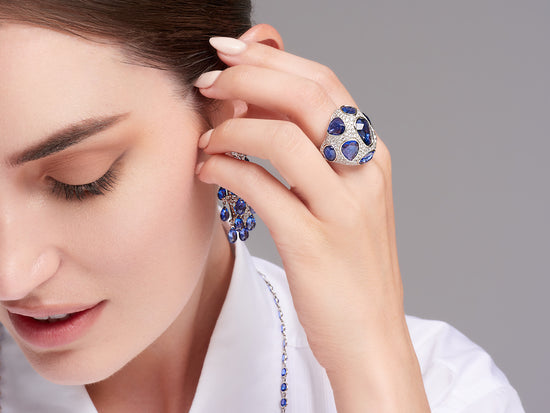Cultured pearls come in different sizes, shapes, and colors.

Perhaps the best-loved gems of all time, pearls—both natural and modern cultured pearls—occur in a wide variety of colors. The most familiar colors are white and cream (a light yellowish brown). Black, gray, and silver are also fairly common, but the palette of pearl colors extends to every hue. The main color, or bodycolor, is often modified by additional colors called overtones, which are typically pink (sometimes called rosé), green, purple, or blue. Some pearls also show the iridescent phenomenon known as orient.

This newly opened akoya pearl oyster reveals the cultured pearl that grew inside its gonad. This oyster’s scientific name is pinctada fucata (martensii).
Cultured pearls are popular for bead necklaces and bracelets, or mounted in solitaires, pairs, or clusters for use in earrings, rings, and pendants. Larger pearls with unusual shapes are popular with creative jewelry designers.

This multicolored necklace combines the beauty of Tahitian and South Sea cultured pearls. The scientific names of the oysters that produced them are, respectively, Pinctada margaritifera and Pinctada maxima. - Courtesy Frank Mastoloni & Sons, Inc.
Pearl—natural or cultured—is a US birthstone for June, together with alexandrite and moonstone.
NATURAL PEARLS VS. CULTURED PEARLS
Natural Pearls
Natural pearls form in the bodies, or mantle tissue, of certain mollusks, usually around a microscopic irritant, and always without human help of any kind.
Cultured Pearls
The growth of cultured pearls requires human intervention and care. Today, most of the mollusks used in the culturing process are raised specifically for that purpose, although some wild mollusks are still collected and used.

This group of cultured pearls displays some of the exotic colors pearls can exhibit. - Blaire Beavers, courtesy Takayas Mizuno
To begin the process, a skilled technician takes mantle tissue from a sacrificed mollusk of the same species and inserts a shell bead along with a small piece of mantle tissue into a host mollusk’s gonad, or several pieces of mantle tissue without beads into a host mollusk’s mantle. If a bead is used, the mantle tissue grows and forms a sac around it and secretes nacre inward and onto the bead to eventually form a cultured pearl. If no bead is used, nacre forms around the individual implanted mantle tissue pieces. Workers tend the mollusks until the cultured pearls are harvested.
PEARL TYPES
There are four major types of cultured whole pearls:
Akoya Cultured Pearls
Akoya cultured pearls are the most familiar type of saltwater cultured pearl to most people in the U.S and other western markets. Many customers think of white or cream colored akoyas as the classic pearl used for jewelry, especially single-strand necklaces. Japan and China both produce akoya cultured pearls.
South Sea Cultured Pearls
Australia, Indonesia, and the Philippines are leading sources of these saltwater cultured pearls. South Sea cultured pearls can be white to silver or golden, depending on the type of oyster. Their large size and thick nacre, due to a long growth period, plus their limited critical growing conditions are all factors contributing to their value.
Tahitian Cultured Pearls
Cultivated primarily around the islands of French Polynesia (the most familiar of these is Tahiti). These saltwater cultured pearls, sometimes referred to as black pearls, have a wide color range. They might be gray, black or brown, and they can have blue, green, purple or pink overtones.
Freshwater Cultured Pearls
Freshwater cultured pearls are the most commonly produced pearls and they are one of the most popular pearl types among shoppers and jewelry designers. This is due to their remarkable range of sizes, shapes and colors, plus their commercial availability at lower price points. They are usually cultured in freshwater lakes and ponds, often with many pearls grown in one oyster. China is the leading source for freshwater cultured pearls.

Cultured pearls from Australia, Indonesia, the Philippines, and Myanmar, are grown in the Pinctada Maxima mollusk. This shell one is called gold-lipped because of the color of the outer rim of its mother-of-pearl layer.

The black-lipped mollusk can produce a variety of cultured pearl colors. The color of the mother-of-pearl layer is often related to the color of the resulting cultured pearl’s nacre. - Courtesy A & Z Pearls and Tasaki Shinju Co





